We use cookies to ensure you get the best browsing experience. By continued use, you agree to our privacy policy and accept our use of such cookies. For further information, click FIND OUT MORE.
Living in Talim Island in Binangonan, Rizal, the waters of Laguna de Bay has, for generations, been the source of bounty for fisherfolk engaged in pamamanti. For decades, residents have counted on blessings from the lake to ease their burden. Today, however, the waters they've come to depend on are no longer as generous.
GREGORIO AÑAIN, 64, was born and bred in Talim Island.
He first went fishing in Laguna de Bay with his father when he was 12. It's still something he does today for a living, this time with his son Melvin.
Pamamanti is what the locals call fishing and it is the main source of livelihood of some residents in Barangay Kaytome in Talim Island.
Like his father, Melvin never finished school. He doesn't have his own family, so he has been helping his mother and his father at home.
If Melvin had his way, his father would just be staying at home instead of coming out with him to the shores.
"Kasi po matanda na po siya, dapat nga hindi na niya kailangan mangisda, kasi meron na siyang edad. Kung tutuusin po dapat hindi na siya kasama. Pero dahil sa pangangalangan, napipilitan siyang mangisda para lang may makain ang aming pamilya," Melvin says.
("He is old. He shouldn't have to go out fishing because he is getting older. He should not be accompanying me. But he is forced to do so just so our family has food to eat.")
But a family has got to eat, so everyone must pull their weight.
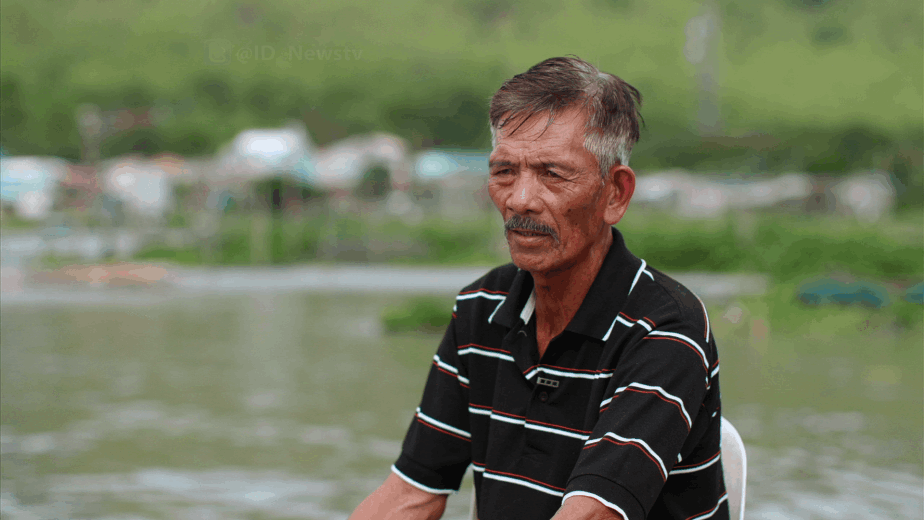
Gregorio Añain, 64
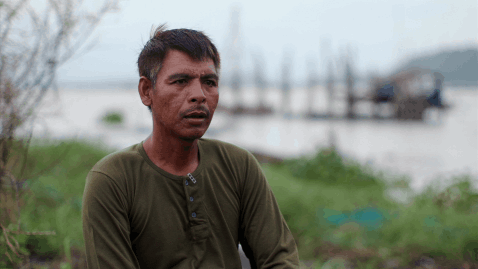
Melvin Añain, 40
In the morning, the men purchase liters of gas to fuel their motor boat and food to fuel themselves. They would share a single serving and try to make it last until lunch.
Some days, they wouldn't have enough money for gas or food, so they buy it on credit, with the promise to pay back once they sell their catch.
When they reach a spot in the lake, they release the net — the panti — and hit the surface of the water with a stick.
Then, they hope for the best.
Two hours pass and they have yet to catch a single fish.
"Sa ngayon po wala tayong nahuli. Naka-isang kalat tayo. Ngayon lilipat tayo ng ibang lugar naman," Gregorio says. "Hindi tayo titigil hanggang walang huli."
("For now, we haven't caught anything yet. We will move to another area. We won't stop until we have some catch.")
After nearly six hours on the lake, the two check their haul: nine tilapia, one carp, and two kanduli.
FISHING IN LAGUNA DE BAY wasn't always a miserable experience. Decades ago, fisherfolk would bring home a sizeable bounty. After feeding their families, they would have enough left over to sell for catch that would get them by.
Gregorio still remembers when fish were abundant in the 1980s. In just two hours, fishermen would have already caught six to seven kilos of tilapia.
"Kung ikukumpara namin, nung una talagang sagana ang isda. Mga panahong yun, malinaw ang dagat. Ngayon talagang ganito na ang aming dagat. Marumi, malabo kaya po ang isda, napakahirap talaga," he says.
("If we compare, fish were really abundant in those days. The waters were clear. Now the waters are dirty and murky, so it's hard to catch fish.")
More than 12,000 fishermen rely on the 90,000-hectare Laguna de Bay for their livelihood.
According to data from the Philippine Statistics Authority, the fish produced in the Calabarzon region, where Laguna de Bay is located, has been decreasing in the past few years: from 413,395.44 metric tons in 2010, it dropped to 331,240.14 metric tons in 2016.
Fishermen believe that the murky water is responsible for their dwindling catch. They say they only catch five to ten kilos if the water is milky, and 30 to 40 kilos if the water is clear.
The Laguna Lake Development Authority say that the reasons behind the murky water involves environmental factors, and interestingly enough, Manila Bay.
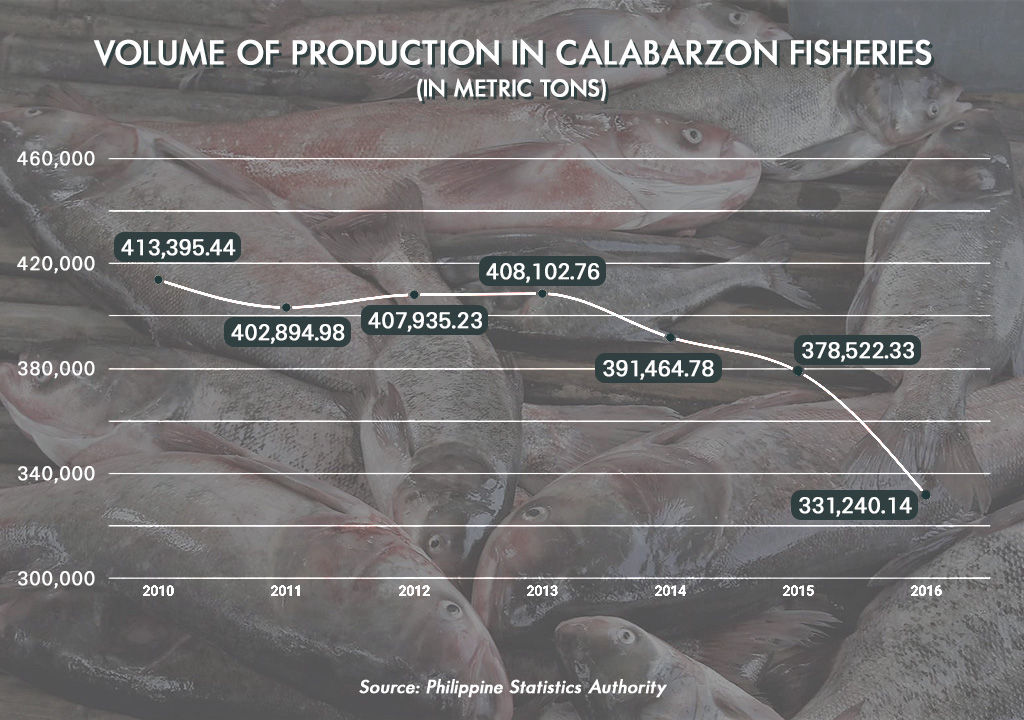
MUDDY WATERS ARE A RESULT of the mire in the lake, which is caused by disturbances in the surrounding environment, such as the cutting down of trees to make way for houses.
It is not just color of the water that is affected by environment factors.
The onslaught of waste triggers what's called an "algal bloom."
"May instances lalo na yung tinatawag na blue-green algae, nagiging part sila ng certain taste, ang local term is lasang liya," says Adelina Santos-Borja, manager of the Resource-Management and Development Department of the Laguna Lake Development Authority.
("The blue and green algae gives the fish a certain unpleasant taste.")
Fish are hard to sell if the smell or taste is unpleasant so they are sold at a cheaper price. From P30 per kilo, the price drops to P10 to P20 per kilo.
Some buyers won't purchase them if there's a smell, says Teresita Añain, who sells fish at Binangonan Market.
The heat triggers this off-putting smell, but disappears during the rainy season, she says.
Adelina says algal blooms in the lake are caused mainly by untreated waste.
"Ang ating lake ay maraming fertilizer. 'Yun yung tinatawag nating nitrates, phosphates. Ang pinapanggalingan nito ay untreated organic wastes, so dumi ng tao, dumi ng hayop, household watstes. Kung hindi yan ma-ti-treat ng husto, lahat yan, saan ba pupunta? Pwedeng una sa canal, pupunta sa ilog, pupunta sa Laguna Lake," she says.
("There's a lot of fertilizer in the lake — nitrates, phosphates. These come from untreated organic wastes — human, animal, household waste. If they're not treated, where would it go? It would go to canals, down to the rivers, then finally to Laguna Lake.")
The presence of the carnivorous knifefish is also a factor in the decrease in the productivity of the lake. Different agencies are already coordinating to try to address the issue.
Despite all these issues, the waters of Laguna de Bay are graded Class C — they remain safe for fishing. The LLDA hopes it could have more monitoring stations to get better data, but so far, the waters remain good enough, even for pamamanti.
"There's a lot of fertilizer in the lake — nitrates, phosphates. These come from untreated organic wastes — human, animal, household waste. If they're not treated, where would it go? It would go to canals, down to the rivers, then finally to Laguna Lake."
ADELINA SANTOS-BORJA
Manager, Resource-Management and Development Department
Laguna Lake Development Authority
WHAT HELPS CLEAR UP THE LAKE is salt water from Manila Bay, which periodically travels through Pasig River and into Laguna de Bay.
When salt water mixes with fresh water, the lake clears and the fish turn out fatter and healthier.
"Kailan lumilinaw ang lawa? Nakapakaganda ng design ng Laguna Lake kung tutuusin, yung kamay ng Diyos sa Laguna Lake. Kasi ang laki, ang babaw, lumalabo, pero periodically pumapasok yung tubig alat galing Manila Bay, sa Pasig River, sa Laguna Lake," says Santos-Borja.
"'Pag yan sumasama sa tubig sa lawa, 'di ba sabi ko maraming naka-suspend diyan. Sa chemistry tawag diyan magfo-form ng block, mag-a-attract yung positive at negative. 'Pag marami silang nabuo ng ganyan, medyo bumibigat, bumababa yan, nag-se-settle. Kaya may instances hanggang dun sa ilalim ng lawa makikita mo ang ilalim, ganoon kalinaw."
("When does the lake water clear? If you think about it, the formation of Laguna Lake is beautiful, like God had a hand in it. It is huge and shallow, and while it turns murky, salt water from Manila Bay periodically enters the Laguna Lake through the Pasig River. When fresh water mixes with salt water, it forms a block. The positives and negatives attract each other, sinks, and settles. There'd be instances when one can see the bottom of the lake, that's how clear it becomes.")
But every time there's a storm, the Napindan Hydrolic Control Project in Pasig is closed, blocking the salt water from getting back into Laguna de Baythrough Pasig River.
The older fishermen couldn't help but notice how salt water does not get to Laguna Lake as often as it used to anymore.
"Taon-taon po noon dumadaan talaga po 'yun, hindi po talaga nauubos ang isda. Pero kung magagawan po ng paraan yung Ilog Pasig na mapasukan kaming tubig alat, maganda po. Noong araw po talagang pinapasok kami ng tubig alat galing sa Manila Bay pero ngayon po hindi eh. Pag hindi po nabuksan yun yung mga isda po dito, wala payat po," a fisherman says.
("Back then,the salt water would get here every year, and we don't run out of fish. If someone can find a way for salt water to always reach us, that would be great. Salt water from the Manila Bay hardly reaches us anymore, so the fish are thin.")
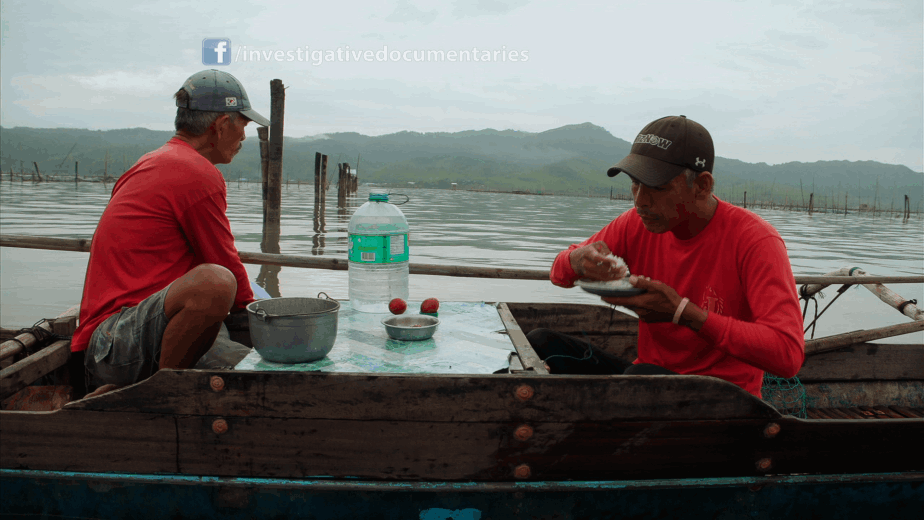
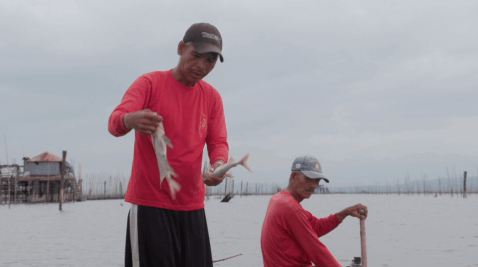
FOR THE DAY, Gregorio and Melvin's catch amounts to five kilos of tilapia and three kilos of carp.
The fish would earn them P30 per kilo, giving the family a return of P240.
Of this, P140 would go to the two liters of gas and the food they bought on credit earlier, leaving them with just P100 for a day of work.
Gregorio surrenders the money to his wife, Leonora, who is in charge of the budget.
"Hindi pa po sapat dahil yung kabayaran ng aming huli ay ibabayad namin sa inutang na gasolina at ulam na inutang din namin, dinala sa laot. Ang natira lang ay mahigit isang daan lang. Kung tutuusin dalawang kilong bigas lang ang mabibili nun at saka wala nang pang-ulam," Melvin says.
("It is not enough because the money we earn, we use to pay for our debts. Only P100 would remain, and that can only buy us two kilos of rice.")
To contribute to the family's finances, Leonora works on the side as a seamstress. She earns P7 for every uniform she finishes making. In one week she can finish three dozen uniforms, and in one month she can earn up to P1000.
Recently though, she has not been able to sew anything because their electricity was cut after they were unable to pay for two months.
With the family struggling with finances, Gregorio and Melvin have been trying to find other ways to bring in more cash.
Every once in a while, the two climb up the mountain to collect wood. When they chance upon wood in the lake, they pick them up as well. Melvin would build chicken coops from the wood they collect, which they would sell for P500.
Gregorio, meanwhile, earns a little money on the side by sharpening saws.
But even though living life day to day is getting harder, Gregorio has never thought about leaving the island.
"Talagang mahal ko 'tong isla namin, dito na 'ko pinanganak, pati mga magulang ko dito tumanda, lolo ko dito nangidad. OK naman sa akin, nakakaraos pa rin kahit mahirap. Dahil lang sa tiyaga, pagtitiisan na lang namin yung ganung kahirapan makaraos lang sa pang-araw-araw," he says.
("I love our island. I was born here, my parents grew up here, my grandfather grew old here. It's OK with me, we get by even if it's hard. We will endure the hardships just so we can survive every day.")
Pamamanti ang tawag sa paghuli ng isda sa Talim Island, Binangonan Rizal. Ito ang karaniwang hanapbuhay ng mga residente sa lugar.
Pero ayon sa Philippine Statistics Authority (PSA), bumaba ito noong 2017. Ang paglabo ng tubig sa Laguna de Bay ang isa sa mga itinuturong sanhi ng problema. Alamin kung ano ang sitwasyon ng mga mamamanti sa Binangonan at paano ito sinusolusyunan ng pamahalaan.